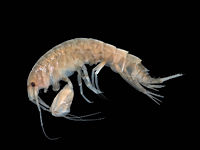Portal:Crustaceans
The Crustaceans Portal Crustaceans are a group of arthropods that are a part of the subphylum Crustacea (/krəˈsteɪʃə/), a large, diverse group of mainly aquatic arthropods including decapods (shrimps, prawns, crabs, lobsters and crayfish), seed shrimp, branchiopods, fish lice, krill, remipedes, isopods, barnacles, copepods, opossum shrimps, amphipods and mantis shrimp. The crustacean group can be treated as a subphylum under the clade Mandibulata. It is now well accepted that the hexapods (insects and entognathans) emerged deep in the Crustacean group, with the completed group referred to as Pancrustacea. The three classes Cephalocarida, Branchiopoda and Remipedia are more closely related to the hexapods than they are to any of the other crustaceans (oligostracans and multicrustaceans). The 67,000 described species range in size from Stygotantulus stocki at 0.1 mm (0.004 in), to the Japanese spider crab with a leg span of up to 3.8 m (12.5 ft) and a mass of 20 kg (44 lb). Like other arthropods, crustaceans have an exoskeleton, which they moult to grow. They are distinguished from other groups of arthropods, such as insects, myriapods and chelicerates, by the possession of biramous (two-parted) limbs, and by their larval forms, such as the nauplius stage of branchiopods and copepods. Most crustaceans are free-living aquatic animals, but some are terrestrial (e.g. woodlice, sandhoppers), some are parasitic (e.g. Rhizocephala, fish lice, tongue worms) and some are sessile (e.g. barnacles). The group has an extensive fossil record, reaching back to the Cambrian. More than 7.9 million tons of crustaceans per year are harvested by fishery or farming for human consumption, consisting mostly of shrimp and prawns. Krill and copepods are not as widely fished, but may be the animals with the greatest biomass on the planet, and form a vital part of the food chain. The scientific study of crustaceans is known as carcinology (alternatively, malacostracology, crustaceology or crustalogy), and a scientist who works in carcinology is a carcinologist. (Full article...) Selected article
Metanephrops challengeri (commonly known as the New Zealand lobster or New Zealand scampi) is a species of slim, pink lobster that lives around the coast of New Zealand. It is typically 13–18 cm (5–7 in) long and weighs around 100 g (3.5 oz). The carapace and abdomen are smooth, and adults are white with pink and brown markings and a conspicuous pair of long, slim claws. M. challengeri lives in burrows at depths of 140–640 m (460–2,100 ft) in a variety of sediments. Although individuals can live for up to 15 years, the species shows low fecundity, where small numbers of larvae hatch at an advanced stage.
M. challengeri is a significant prey item for ling, as well as being an important fishery species for human consumption; trawlers catch around 1,000 t (2,200,000 lb) per year under the limitations of New Zealand's Quota Management System. The species was first collected by the Challenger expedition of 1872–1876, but only described as separate from related species by Heinrich Balss in 1914. Although originally classified in the genus Nephrops, it was moved in 1972 to a new genus, Metanephrops, along with most other species then classified in Nephrops. Did you know?
Selected biography
Thomas Bell FRS (October 11, 1792 – March 13, 1880) was an English zoologist, surgeon and writer, born in Poole, Dorset, UK. Bell, like his mother Susan, took a keen interest in natural history which his mother also encouraged in his younger cousin Philip Henry Gosse. Bell left Poole in 1813 for his training as a dental surgeon in London. He combined two careers, becoming Professor of Zoology at King's College London in 1836 (on the strength of his amateur researches) and lecturing on anatomy at Guy's Hospital. He became a Fellow of the Royal College of Surgeons in 1844. He was President of the Linnean Society in 1858. Bell was at the heart of the scientific establishment and when Charles Darwin returned to London from the Beagle expedition on December 2, 1836, Bell was quick to take on the task of describing the reptile specimens. He was also entrusted with the specimens of crustaceans collected on the voyage. He was the authority in this field; his book British Stalked-eye Crustacea is a masterwork.
Selected image Periclimenes imperator (Decapoda: Palaemonidae) is a species of shrimp with a wide distribution across the Indo-Pacific that lives commensally on a number of hosts, including the sea slug Hexabranchus. General imagesThe following are images from various crustacean-related articles on Wikipedia.
Crustacean lists
SubcategoriesRelated portalsWikiProjectsAssociated WikimediaThe following Wikimedia Foundation sister projects provide more on this subject:
Discover Wikipedia using portals
|






















































